The Reinforcement Geosynthetics Market is estimated to be valued at USD 3.4 billion in 2025 and is projected to reach USD 9.4 billion by 2035, registering a compound annual growth rate (CAGR) of 10.7% over the forecast period.
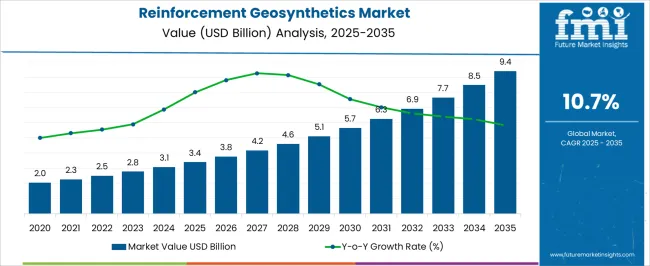
| Metric | Value |
|---|---|
| Reinforcement Geosynthetics Market Estimated Value in (2025 E) | USD 3.4 billion |
| Reinforcement Geosynthetics Market Forecast Value in (2035 F) | USD 9.4 billion |
| Forecast CAGR (2025 to 2035) | 10.7% |
The Reinforcement Geosynthetics market is experiencing sustained growth driven by the increasing demand for durable and cost-effective soil stabilization and reinforcement solutions across civil engineering and infrastructure projects. The market is being influenced by the expansion of road networks, urbanization, and the growing need for sustainable construction practices that reduce maintenance costs and enhance structural longevity. Technological advancements in geosynthetic materials have enabled improved load-bearing capacity, erosion control, and adaptability to varying soil conditions, increasing their adoption in challenging terrains.
The future outlook is shaped by rising investments in transportation infrastructure, including highways, embankments, and airport pavements, particularly in developing regions. Increasing emphasis on environmental protection and reduction of carbon footprints in construction practices is further supporting the adoption of reinforcement geosynthetics.
Modular and high-performance products that offer long-term durability and reduce the frequency of rehabilitation are emerging as preferred solutions As infrastructure demands continue to rise globally, the market is poised for robust expansion with reinforced soils playing a critical role in sustainable and resilient civil engineering projects.
The reinforcement geosynthetics market is segmented by product type, application, and geographic regions. By product type, reinforcement geosynthetics market is divided into Geotextiles Reinforcement Geosynthetics, Geo-Composites Reinforcement Geosynthetics, and Geofoam Reinforcement Geosynthetics. In terms of application, reinforcement geosynthetics market is classified into Road Construction & Embankment, Bridges Abutment & Infilling, Landfill & Erosion Control, Railways Construction, Structural Base Infill, Retaining Walls, Waterworks And Waste Treatments, and Others. Regionally, the reinforcement geosynthetics industry is classified into North America, Latin America, Western Europe, Eastern Europe, Balkan & Baltic Countries, Russia & Belarus, Central Asia, East Asia, South Asia & Pacific, and the Middle East & Africa.
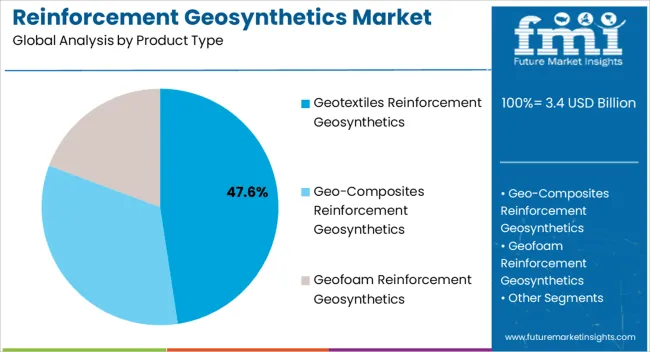
The Geotextiles Reinforcement Geosynthetics product type is projected to hold 47.60% of the market revenue share in 2025, making it the leading segment. This dominance is being driven by the material’s flexibility, strength, and ease of installation, which make it suitable for a wide range of civil engineering applications. The growth of this segment has been supported by its ability to provide enhanced soil stabilization, reduce settlement, and increase load-bearing capacity in infrastructure projects.
Geotextiles reinforcement geosynthetics are being preferred because they allow for quick deployment, minimize construction time, and offer compatibility with diverse soil types. Their widespread acceptance is also due to their environmental benefits, including reduced use of natural aggregates and improved sustainability in construction projects.
As urbanization intensifies and road and highway networks expand, the demand for geotextiles reinforcement geosynthetics is expected to remain strong The segment benefits from the growing need for reliable, durable, and cost-effective reinforcement solutions that improve structural performance while lowering maintenance requirements.
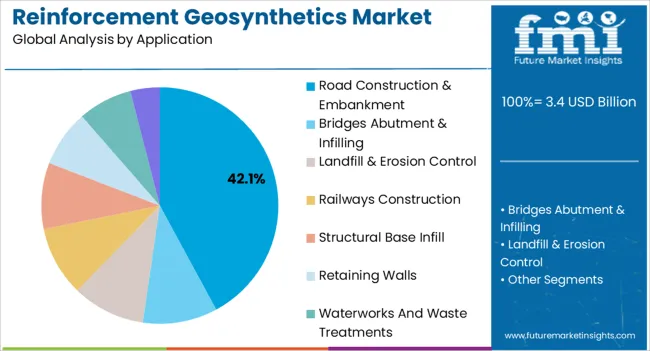
The Road Construction and Embankment application segment is anticipated to capture 42.10% of the market revenue in 2025, positioning it as the largest end-use application. This growth is being driven by the critical role that reinforcement geosynthetics play in improving pavement performance, controlling soil erosion, and enhancing embankment stability.
Adoption has been accelerated by the increasing construction of highways, urban roads, and elevated embankments, where long-term durability and reduced maintenance are key priorities. Reinforcement geosynthetics are being favored for their ability to distribute loads evenly, prevent differential settlement, and extend the service life of road infrastructure.
The segment is also benefiting from growing investments in public infrastructure and sustainable construction practices, which prioritize environmentally friendly materials and efficient resource utilization As governments and private developers continue to invest in large-scale transportation networks, the Road Construction and Embankment segment is expected to sustain leadership due to its proven effectiveness in strengthening soil structures and supporting reliable, long-lasting infrastructure.
Geosynthetics materials are widely used in infrastructural projects. They are mainly used for the purpose of subgrade separation, base reinforcement, filtration and stabilisation and drainage facility along with overlay stress absorption and reinforcement. Separation is a method of breaking contact between two or more surfaces or materials.
Often, the separation of different layers or course granules is desired while construction. Generally, in the construction of rail tracks, roads, shallow foundations and embankments, a layer of geosynthetic material is placed at the interface of soft foundation, soil and the overlying granular layer. This is essential for reinforcement and proper stress distribution among the layers. Filtration restricts the movement of soil while it allows water to move from the filtered soil to the coarser soil adjacent to it. Lateral drainage or transmission is applied at the place of lateral movement of water within the plane of the geosynthetics. The reinforcement geosynthetics material is the addition of structural and load-carrying capacity to a pavement system for the transfer of load to the geosynthetics material.
Reinforcement geosynthetics are used to provide strength to the base structure as they improve the mechanical properties of a soil mass. When reinforcement geosynthetics are combined with soil, they form reinforced soil composites having high compressive and tensile strengths. In this procedure, reinforcement geosynthetics act as tensioned members, coupled with the fill material/soil, by friction, adhesion, interlocking or confinement and thus maintains the stability in the soil mass.
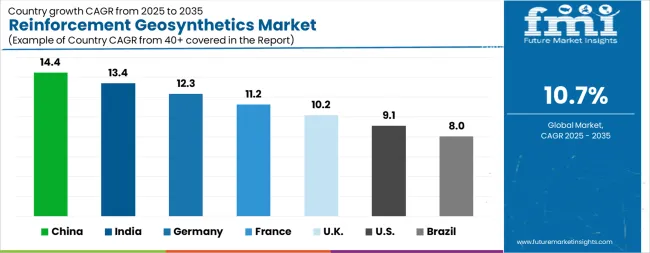
| Country | CAGR |
|---|---|
| China | 14.4% |
| India | 13.4% |
| Germany | 12.3% |
| France | 11.2% |
| UK | 10.2% |
| USA | 9.1% |
| Brazil | 8.0% |
The Reinforcement Geosynthetics Market is expected to register a CAGR of 10.7% during the forecast period, exhibiting varied country level momentum. China leads with the highest CAGR of 14.4%, followed by India at 13.4%. Developed markets such as Germany, France, and the UK continue to expand steadily, while the USA is likely to grow at consistent rates. Brazil posts the lowest CAGR at 8.0%, yet still underscores a broadly positive trajectory for the global Reinforcement Geosynthetics Market. In 2024, Germany held a dominant revenue in the Western Europe market and is expected to grow with a CAGR of 12.3%. The USA Reinforcement Geosynthetics Market is estimated to be valued at USD 1.3 billion in 2025 and is anticipated to reach a valuation of USD 3.0 billion by 2035. Sales are projected to rise at a CAGR of 9.1% over the forecast period between 2025 and 2035. While Japan and South Korea markets are estimated to be valued at USD 174.3 million and USD 91.8 million respectively in 2025.
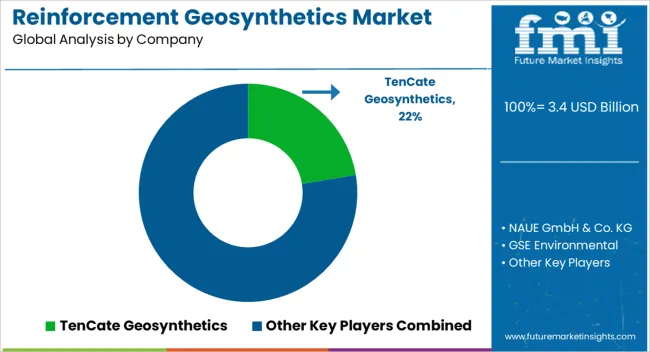
| Item | Value |
|---|---|
| Quantitative Units | USD 3.4 Billion |
| Product Type | Geotextiles Reinforcement Geosynthetics, Geo-Composites Reinforcement Geosynthetics, and Geofoam Reinforcement Geosynthetics |
| Application | Road Construction & Embankment, Bridges Abutment & Infilling, Landfill & Erosion Control, Railways Construction, Structural Base Infill, Retaining Walls, Waterworks And Waste Treatments, and Others |
| Regions Covered | North America, Europe, Asia-Pacific, Latin America, Middle East & Africa |
| Country Covered | United States, Canada, Germany, France, United Kingdom, China, Japan, India, Brazil, South Africa |
| Key Companies Profiled | TenCate Geosynthetics, NAUE GmbH & Co. KG, GSE Environmental, Officine Maccaferri, Low & Bonar (Freudenberg), HUESKER Group, Fibertex Nonwovens, and AGRU Kunststofftechnik |
The global reinforcement geosynthetics market is estimated to be valued at USD 3.4 billion in 2025.
The market size for the reinforcement geosynthetics market is projected to reach USD 9.4 billion by 2035.
The reinforcement geosynthetics market is expected to grow at a 10.7% CAGR between 2025 and 2035.
The key product types in reinforcement geosynthetics market are geotextiles reinforcement geosynthetics, geo-composites reinforcement geosynthetics and geofoam reinforcement geosynthetics.
In terms of application, road construction & embankment segment to command 42.1% share in the reinforcement geosynthetics market in 2025.






Our Research Products

The "Full Research Suite" delivers actionable market intel, deep dives on markets or technologies, so clients act faster, cut risk, and unlock growth.

The Leaderboard benchmarks and ranks top vendors, classifying them as Established Leaders, Leading Challengers, or Disruptors & Challengers.

Locates where complements amplify value and substitutes erode it, forecasting net impact by horizon

We deliver granular, decision-grade intel: market sizing, 5-year forecasts, pricing, adoption, usage, revenue, and operational KPIs—plus competitor tracking, regulation, and value chains—across 60 countries broadly.

Spot the shifts before they hit your P&L. We track inflection points, adoption curves, pricing moves, and ecosystem plays to show where demand is heading, why it is changing, and what to do next across high-growth markets and disruptive tech

Real-time reads of user behavior. We track shifting priorities, perceptions of today’s and next-gen services, and provider experience, then pace how fast tech moves from trial to adoption, blending buyer, consumer, and channel inputs with social signals (#WhySwitch, #UX).

Partner with our analyst team to build a custom report designed around your business priorities. From analysing market trends to assessing competitors or crafting bespoke datasets, we tailor insights to your needs.
Supplier Intelligence
Discovery & Profiling
Capacity & Footprint
Performance & Risk
Compliance & Governance
Commercial Readiness
Who Supplies Whom
Scorecards & Shortlists
Playbooks & Docs
Category Intelligence
Definition & Scope
Demand & Use Cases
Cost Drivers
Market Structure
Supply Chain Map
Trade & Policy
Operating Norms
Deliverables
Buyer Intelligence
Account Basics
Spend & Scope
Procurement Model
Vendor Requirements
Terms & Policies
Entry Strategy
Pain Points & Triggers
Outputs
Pricing Analysis
Benchmarks
Trends
Should-Cost
Indexation
Landed Cost
Commercial Terms
Deliverables
Brand Analysis
Positioning & Value Prop
Share & Presence
Customer Evidence
Go-to-Market
Digital & Reputation
Compliance & Trust
KPIs & Gaps
Outputs
Full Research Suite comprises of:
Market outlook & trends analysis
Interviews & case studies
Strategic recommendations
Vendor profiles & capabilities analysis
5-year forecasts
8 regions and 60+ country-level data splits
Market segment data splits
12 months of continuous data updates
DELIVERED AS:
PDF EXCEL ONLINE
Geosynthetics Industry Analysis in South Asia Growth - Trends & Forecast 2025 to 2035
Geosynthetics Market Growth - Trends & Forecast 2025 to 2035
Hose Reinforcement Wires Market Analysis Size and Share Forecast Outlook 2025 to 2035
Sound Reinforcement Market Size and Share Forecast Outlook 2025 to 2035
Seismic Reinforcement Material Market Size and Share Forecast Outlook 2025 to 2035
Demand for Geosynthetics in South Asia Size and Share Forecast Outlook 2025 to 2035
Automotive Rear Seat Reinforcement Market Growth – Trends & Forecast 2024-2034

Thank you!
You will receive an email from our Business Development Manager. Please be sure to check your SPAM/JUNK folder too.
Chat With
MaRIA